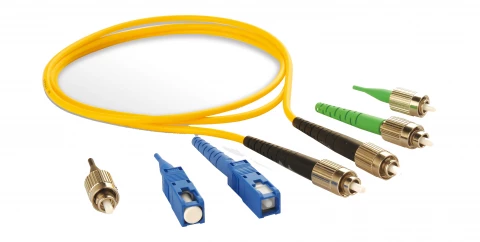2 um Connector Patchcord
Description
The GKER Photonics GK-P Series Single Mode Patchcord is designed to deliver high-performance connectivity for advanced optical applications. With exceptional environmental stability, this patchcord series ensures reliable performance in varying conditions, making it ideal for demanding environments. It features a high return loss and low insertion loss, ensuring minimal signal degradation and maximizing system efficiency. The low polarization dependence further enhances its suitability for precision applications.
This patchcord is perfectly suited for integration into fiber lasers, test instrumentation, and other optical systems requiring precise and stable signal transmission. The GK-P Series is available with multiple connector types, including FC, SC, and LC, in both UPC and APC configurations, offering flexibility in system design. Additionally, the patchcord supports key wavelengths of 1950 nm and 2000 nm, providing compatibility with a wide range of optical setups. The robust design and compatibility with SMF-28 and SM1950 fibers make it a versatile choice for high-performance optical networks.
2 um Connector Patchcord
Specifications |
|
|---|---|
| Wavelength Range: | 1908 – 2050 nm |
| Cable Length: | 12 m |
| Fiber Core Material: | Silica |
| Connector Type: | UPC APC - |
| Wavelength: | 1950 , 2000 nm |
| Typ. Insertion Loss: | 0.3 0.4 dB |
| Max. Insertion Loss: | 0.5 dB |
| Min. Return Loss: | 50 60 dB |
| Max. Optical Power (Continuous Wave): | 300 mW |
| Fiber Length Tolerance: | ± 10 or specified % |
| Operating Temperature: | - 5 to + 70 ℃ |
| Storage Temperature: | - 40 to + 85 ℃ |
Features
- High Return Loss: Ensures excellent signal reflection with a minimum return loss of 50 dB (UPC) and 60 dB (APC)
- Low Insertion Loss: Provides efficient signal transmission with a typical insertion loss of 0.3 dB
- Low Polarization Dependence: Maintains signal integrity across varying polarization states, ideal for precision applications
- Excellent Environmental Stability: Operates reliably across a temperature range of -5°C to +70°C
- Versatile Compatibility: Available with multiple connector types and wavelengths for various optical systems
- High Optical Power Handling: Capable of managing continuous optical power up to 300 mW
Applications
- Fiber Lasers: Ideal for integration into fiber laser systems where stable and low-loss connections are critical
- Test Instrumentation: Perfect for use in optical test equipment requiring precise and reliable signal transmission
- Advanced Optical Networks: Suitable for high-performance optical communication systems, providing reliable connectivity
For pricing, technical or any other questions please contact the supplier
- No registration required
- No markups, no fees
- Direct contact with supplier
-
Ships from:
China
-
Sold by:
-
On FindLight:
since 2024
Frequently Asked Questions
The typical insertion loss for the GK-P Series patchcord is 0.3 dB for UPC connectors and 0.4 dB for APC connectors.
This patchcord supports wavelengths of 1950 nm and 2000 nm, providing compatibility with a wide range of optical systems.
The patchcord can handle continuous optical power up to 300 mW, making it suitable for high-power applications.
The minimum return loss is 50 dB for UPC connectors and 60 dB for APC connectors, ensuring excellent signal reflection.
The patchcord is designed with excellent environmental stability, operating reliably across a temperature range of -5°C to +70°C.
The patchcord is available with multiple connector types, including FC, SC, and LC, in both UPC and APC configurations.
This patchcord is ideal for use in fiber lasers, test instrumentation, and advanced optical networks where high performance and reliability are required.
The patchcord is compatible with SMF-28 and SM1950 fibers, offering versatility for various optical systems.
The patchcord can be safely stored in temperatures ranging from -40°C to +85°C, ensuring durability in extreme conditions.
The fiber length tolerance is ±10% or as specified, allowing for customization to meet specific application needs.

